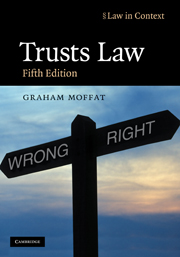Book contents
- Frontmatter
- Contents
- Preface to the fifth edition
- Acknowledgments
- Table of abbreviations
- Useful websites
- Table of statutes
- Table of statutory instruments
- Table of cases
- 1 Trusts introduced
- 2 The evolution of the private express trust
- 3 Taxation, wealth-holding and the private trust
- 4 Creating the trust – I
- 5 Creating the trust – II
- 6 Trusts and public policy
- 7 Flexibility in relation to beneficial entitlement
- 8 The taxation of private trusts
- 9 An introduction to trustees and trusteeship
- 10 Aspects of the management of trusts
- 11 Trusteeship, control and breach of trust
- 12 Implied trusts and the family home
- 13 Trusts in commerce I: occupational pension schemes
- 14 Trusts in commerce II: commerce and equitable remedies
- 15 Trusts in commerce III: commerce, credit and the trust
- 16 Trusts in commerce IV: fiduciary relationships, commerce and the trust
- 17 Trust, contract and unincorporated associations
- 18 An introduction to the law of charity
- 19 A legal definition of ‘charity’
- 20 The regulation of charities
- Index
12 - Implied trusts and the family home
- Frontmatter
- Contents
- Preface to the fifth edition
- Acknowledgments
- Table of abbreviations
- Useful websites
- Table of statutes
- Table of statutory instruments
- Table of cases
- 1 Trusts introduced
- 2 The evolution of the private express trust
- 3 Taxation, wealth-holding and the private trust
- 4 Creating the trust – I
- 5 Creating the trust – II
- 6 Trusts and public policy
- 7 Flexibility in relation to beneficial entitlement
- 8 The taxation of private trusts
- 9 An introduction to trustees and trusteeship
- 10 Aspects of the management of trusts
- 11 Trusteeship, control and breach of trust
- 12 Implied trusts and the family home
- 13 Trusts in commerce I: occupational pension schemes
- 14 Trusts in commerce II: commerce and equitable remedies
- 15 Trusts in commerce III: commerce, credit and the trust
- 16 Trusts in commerce IV: fiduciary relationships, commerce and the trust
- 17 Trust, contract and unincorporated associations
- 18 An introduction to the law of charity
- 19 A legal definition of ‘charity’
- 20 The regulation of charities
- Index
Summary
Introduction
This chapter is concerned with the role played by implied trusts in resolving disputes over the ownership of the family home. It should be noted at the outset that the term ‘family property’ has no specialist meaning in English law: there is no special regime applicable to assets owned by a married couple or civil partners (save when they separate) or to those owned by cohabiting couples and other family members. The situations in which issues of ownership may fall to be determined were set out by the Law Commission in its discussion paper Sharing Homes (Law Commission No 278 (2002)) paras 1.10–1.12:
1.10 Over the last thirty years or so, a recurring question encountered by litigants before the courts in England and Wales has concerned the property entitlements of persons who are sharing, or have shared, homes together. The question arises in various contexts, and the many ways in which it has been answered have emphasised the lack of clear principle in this vital area of the law.
1.11 There are four principal circumstances in which the determination of the ownership of the shared home is highly material and to which we will return throughout this paper: They are as follows:
(1) The persons (two or more) who share a home cease to do so. Typically, one leaves. It may be that this follows the breakdown of a relationship between the sharers. It may be that the living arrangement is no longer convenient to the person who leaves, as they have obtained employment elsewhere. […]
- Type
- Chapter
- Information
- Trusts LawText and Materials, pp. 604 - 668Publisher: Cambridge University PressPrint publication year: 2009



